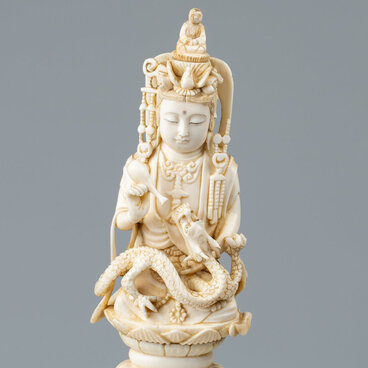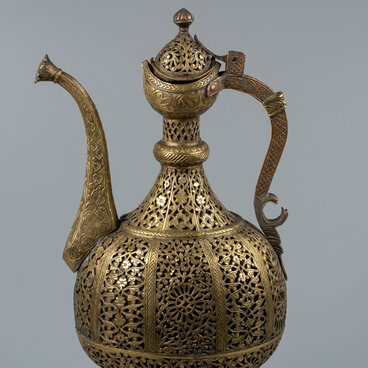The Samara Regional Art Museum presents an elegant vase with an image of a white eagle sitting on the branches of a Japanese maple. The enamel is made in the cloisonné technique.
The word “cloisonné” refers to a technique for decorating enameled metal objects with complex patterns. It is believed that the first item inlaid in cloisonné enamel is the gold mask of Tutankhamun, dated to the 14th century BC.
Enamels came to Japan in the 6th — 7th century through China and Korea. The cloisonné technique in Japan was adopted by local craftsmen. Their peculiar interpretation manifested in more refined vessel shapes and more refined orchestration of enamel colors. Cloisonné enamels flourished in Japan in the 17th century. At that time, the technique was commonly used to decorate Japanese swords.
The development of Japanese cloisonné production is attributed to a former samurai Kaji Tsunekichi (1803 — 1883) from Nagoya. It is believed that around 1838 the samurai got hold of a Chinese cloisonné enamel object for the first time. Kaji Tsunekichi broke it, meticulously studied the composition and created a small cloisonné plate himself. The highest level of cloisonné of the Meiji era (1868 — 1912) remains unattainable up to present day. It often takes years and several artisans to create one enameled item.
When working in the technique of cloisonné enamel, a wire or metal strips are soldered onto the metal surface and the formed cells are filled with glass-paste — enamel. After firing, the surface is smoothly polished, so that the metal and enamel can form a flat plane, while the metal partitions create a specific pattern. This enameling method was especially common in Japan.
The metal base is usually gold, less often silver or copper. First, a glaze is applied to it and then it is painted, after which the surface is covered with a colorless transparent enamel with glaze.
The image on the vase is laconic and minimalistic, which is true to the Japanese traditions and aesthetic. The artist meticulously worked out all the details: the feathers of the eagle, the veins of the leaves, a miniature floral pattern on the neck of the vase. Due to a careful polishing, the soldered wires are almost invisible, and it looks like there are no partitions.
The word “cloisonné” refers to a technique for decorating enameled metal objects with complex patterns. It is believed that the first item inlaid in cloisonné enamel is the gold mask of Tutankhamun, dated to the 14th century BC.
Enamels came to Japan in the 6th — 7th century through China and Korea. The cloisonné technique in Japan was adopted by local craftsmen. Their peculiar interpretation manifested in more refined vessel shapes and more refined orchestration of enamel colors. Cloisonné enamels flourished in Japan in the 17th century. At that time, the technique was commonly used to decorate Japanese swords.
The development of Japanese cloisonné production is attributed to a former samurai Kaji Tsunekichi (1803 — 1883) from Nagoya. It is believed that around 1838 the samurai got hold of a Chinese cloisonné enamel object for the first time. Kaji Tsunekichi broke it, meticulously studied the composition and created a small cloisonné plate himself. The highest level of cloisonné of the Meiji era (1868 — 1912) remains unattainable up to present day. It often takes years and several artisans to create one enameled item.
When working in the technique of cloisonné enamel, a wire or metal strips are soldered onto the metal surface and the formed cells are filled with glass-paste — enamel. After firing, the surface is smoothly polished, so that the metal and enamel can form a flat plane, while the metal partitions create a specific pattern. This enameling method was especially common in Japan.
The metal base is usually gold, less often silver or copper. First, a glaze is applied to it and then it is painted, after which the surface is covered with a colorless transparent enamel with glaze.
The image on the vase is laconic and minimalistic, which is true to the Japanese traditions and aesthetic. The artist meticulously worked out all the details: the feathers of the eagle, the veins of the leaves, a miniature floral pattern on the neck of the vase. Due to a careful polishing, the soldered wires are almost invisible, and it looks like there are no partitions.






